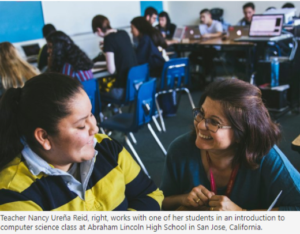
By 2020 there will be 1.4 million computer science-related jobs in the U.S., yet right now, U.S. college graduates are expected to fill less than a third of them. Only 40 percent of U.S. schools offer computer science classes with computer programming, with many school officials citing a shortage of teachers with the necessary skills as a key reason for this gap.
Now in its 10th year, the Microsoft TEALS(Technology Education and Literacy in Schools) program mission is to close this gap. Microsoft also supports the efforts of schools and communities around the world in this work, and specifically, the efforts of Code.org. Recently, Microsoft announced that it would invest an additional $10 million to help expand the nonprofit’s work helping students from kindergarten to high school learn the skills — not just coding but problem-solving, resiliency and creativity — that will be key in careers across nearly all sectors and industries. The renewed partnership will focus on ensuring that by 2020 every state will have passed policies to expand access to computer science and every school in the U.S. will have access to Code.org professional development.
With TEALS, teachers learn in tandem with the students, taught by computer science (CS) professionals who volunteer to help team teach the class. Then, over a period of two school years, the classroom teachers gradually take over the responsibilities of teaching the classes on their own.
TEALS support nearly 500 high schools in the U.S. Teachers and schools in urban and rural areas, large and small, benefit from the program, which in turn helps them have a big impact on kids’ lives and career potential.
At a high school in Silicon Valley in California, you might think all the students are tech-savvy and that they zip around on hoverboards. After all, they live in the heart of a region that’s home to some of the world’s major tech companies.
Nancy Ureña Reid knows better. She’s the computer science and math teacher at Lincoln High School in San Jose, where 60 percent of the school’s 1,900 students qualify for subsidized lunches. Most of their parents don’t work in the tech field.
Teacher Nancy Ureña Reid, right, works with one of her students in an introduction to computer science class at Abraham Lincoln High School in San Jose, California.
With TEALS’ help, Ureña Reid learned how to teach introductory computer science to more than 400 students since 2014.
“As a result of the support I received from TEALS, I gained much confidence to offer more computer science programs at my school and in the Bay Area community,” Ureña Reid says.
She speaks of the real-world experience TEALS volunteers bring into the classroom, as well as their passion for the field.
By empowering the next generation of kids, including minorities who don’t always have the resources to learn about CS, Microsoft hopes to successfully close that gap in demographics and build a diverse workforce in the STEM industries.
To find out what you can do to bring computer science to your community, go to code.org/help.
For more information on TEALS or to inquire about volunteering, go to https://www.microsoft.com/en-us/digital-skills/TEALS
Sources:
